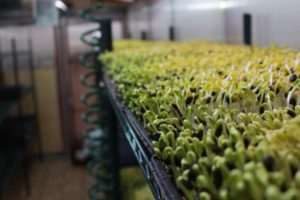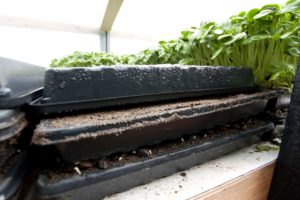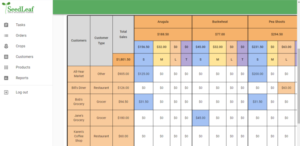Let’s take a look at some microgreens crop planning basics to help set you up for success.
How Does Microgreens Crop Planning Work?
Crop Production
The basic principle of microgreens crop planning is that crops are sowed based on expected or projected product orders. The sowing date and subsequent production tasks are determined by working backwards from your desired harvest/delivery date for those orders to determine:
- Which crops to grow
- How much of each crop to grow
- When to soak or sow those crops to ensure they mature on the desired harvest date
A crop’s soaking or sowing date is determined by its days to maturity (DTM). So a crop that you want to mature on Dec 20, which has 10 days to maturity, needs to be sowed on Dec. 10.
How long a crop stays in the germination stage, depends on its Days to Germinate (DTG). A crop that has 5 DTG and is sowed on Dec. 10 will get uncovered on Dec. 15.
When orders contain product mixes (multiple crops), you can use the percent of each crop in the product to calculate how much crop to grow.
SeedLeaf organizes your seeds, crop, and products on separate pages so each can be customized to your exact needs. SeedLeaf’s flexible design allows you to adapt seed, crop, and product details to help keep you organized.
Customers and Orders
Crops and products are an important part of microgreens crop planning, but so are customers and orders – without them, there is no need for crops and products.
Your customers can include different types such as grocers, restaurants, farmers markets, wholesalers, and home delivery, to name a few. It is important to keep a database of your current and past customers and to record what “type of customer they are. This can help you break down your sales by customer type to better understand how your sales are distributed.
Orders can be done on a case-by-case basis or as a standing order, which repeats on a regular cycle. Your goal should be to encourage customers to set a standing order to make crop planning easier. Most microgreens growers also operate on a grow-to-order basis, meaning you don’t grow a crop unless there is an order for it.
The grow-to-order system is useful for ensuring you are optimizing crop production and reducing the likelihood of waste. But this system does not account for production growth very well as, in theory, you should never have extra crop. But we can plan for extra crop using “virtual customers” – non-existent customers that you grow crop for that can be used for samples, yield shortfalls. Read more about virtual customers here.
Tasks
The ultimate goal of all your crop planning efforts are fivefold:
- To help map out your season to get a sense of what you crop production might look like
- Generate the soaking, sowing, uncovering and harvest tasks for your crop cycles
- Generate packing lists for all of your products on a given harvest day
- Generate customer delivery lists for all of your orders on a given harvest day
- Generate sales and crop production reports for your season
Having a well-organized task list can save you an incredible amount of time and effort AND ensure you have optimized your crop production cycles.
Reports
Being well organized means you can generate accurate reports to summarize your microgreens sales and crop production. This allows you to compare your expected sales and crop production with your actual sales and crop production figures. This can help you accurately adjust your system when needed.
Microgreens crop planning is an art, a science, and a skill. While tools like SeedLeaf can help keep you organized, you also need to apply good management skills to run a successful microgreens business.

